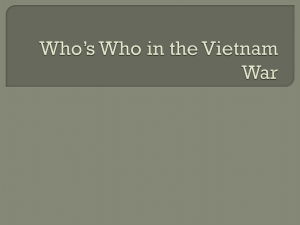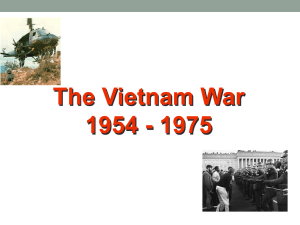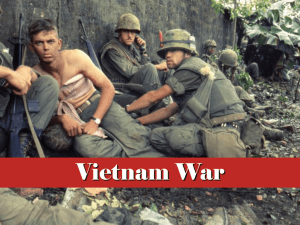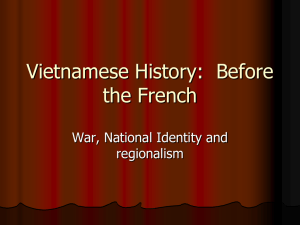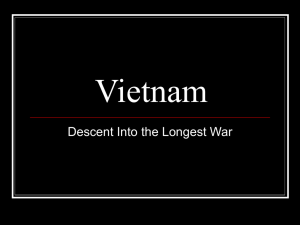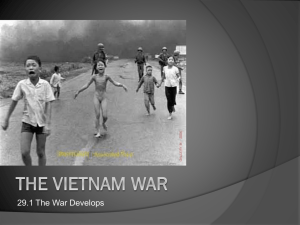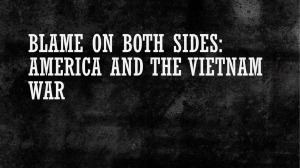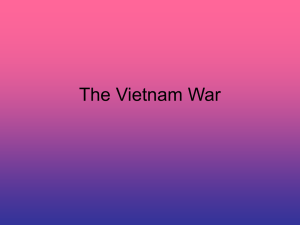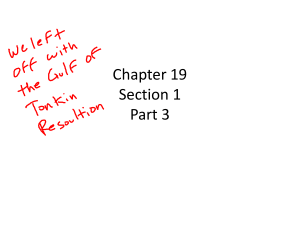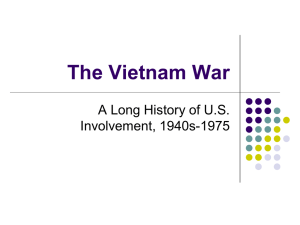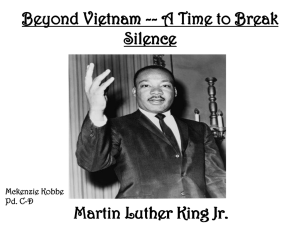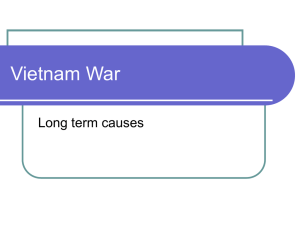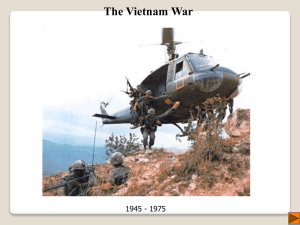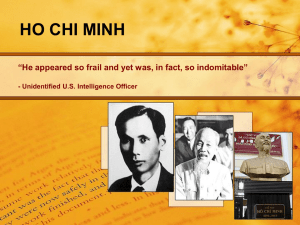Vietnam War
advertisement
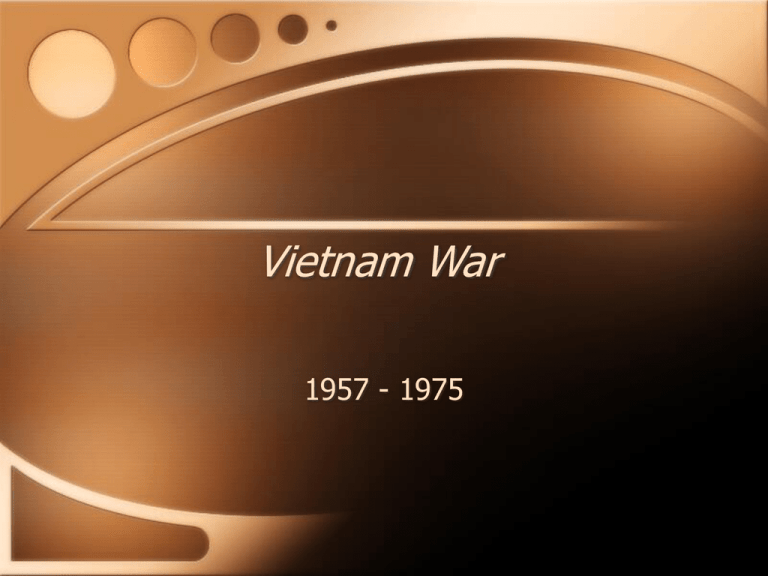
Vietnam War 1957 - 1975 Timeline • 1883 - France takes control of Vietnam, divided into 3 parts • WWII - Japan controlled all of Vietnam • Ho Chi Minh returns to Vietnam from China to fight Japan for Vietnam • Aug. 1945 - Japan is defeated in WWII • Domino Effect - the U.S. worried if Vietnam fell to communism the surrounding countries would fall Timeline continued • Vietminh - revolutionaries fighting for freedom, started by Ho Chi Minh • U.S. supported Minh when they were fighting against Japan • Sep. 1945 - after WWII France moves into Vietnam to regain control of Vietnam • U.S. begins to support France against Ho Chi Minh • 1954 - Vietminh defeat France at Dien Bien Phu Geneva conference • Decisions made at Geneva (1954): • 1. Vietnam would be divided in 1/2 at the 17th parallel • North Vietnam - communist under Ho Chi Minh supported by China and USSR • South Vietnam - Republic of Vietnam under Ngo Dinh Diem - supported by the U.S. • 2. Set up national elections to be held in 1956, but they never happened because they knew Ho Chi Minh would win More on timeline • 1957 - many South Vietnamese civilians revolt against Diem • Vietcong - (National Liberation Front) - civilians living in the south that supported the Vietminh, didn’t like Diem • They lived a seemingly normal life but would fight against the South and the U.S. whenever they could, even though they lived in the South Last of Timeline • 1963 - Southern Generals take over S. Vietnam, Diem is murdered, no leadership in the South emerges • 1967 - Nguyen Van Thieu - elected President of the south until 1975 • 1975 - Saigon falls to communists Presidential involvement in Vietnam • Harry Truman - (1945 - 1953) - supported Minh to fight the Japanese, began to support the French after WWII • Dwight Eisenhower - (1953-1961) - Geneva Accord, sent aid and supplies to support the South (Diem) • John Kennedy - (1961 - 1963) - sent advisors, some military support More on Presidents • LBJ - (1963 - 1969) - ground forces arrive, acknowledge involvement publicly, U.S. begins bombing strikes on the North • He wanted to control communism - containment • Richard Nixon - (1969 - 1974) - bombing continues, peace talks begin • Gerald Ford - (1974 - 1977) - Saigon falls and the U.S. leaves , North and South Vietnam reunify Vietnam War • Ho Chi Minh trail - trail through Laos and Cambodia that troops in North Vietnam would use to infiltrate the South • Gulf of Tonkin incident - Aug. 2, 1964 • - U.S. destroyer the Maddox was attacked by North Vietnam torpedo boats • - U.S. fires back and calls in the C. Turner Joy for reinforcement • - LBJ orders air strikes against the NVA (Vietminh) More on Vietnam • Gulf of Tonkin resolution - after the incident in the Gulf the Senate passed this resolution allowing the President to take any means necessary to prevent further aggression. • Some say the Gulf attacks never happened • 1964 election - LBJ v. Barry Goldwater • Goldwater wanted more action in Vietnam LBJ wins the election Action in Vietnam • Operation Rolling Thunder - 1965 - 68 -- bombing raids on North Vietnam and the Ho Chi Minh trail • Largest operation of the war • Approx. - 92,000 Vietnamese killed during this campaign and 850 Americans • Started after the NVA attacked a U.S. base in the South • Start of U.S. troops in full combat against the NVA More action in Nam • William Westmoreland - Supreme commander of U.S. troops in Vietnam • Time - Man of the Year • Khe Sahn - U.S. marine base held under siege by the NVA for 77 days • Operation Niagara - bombing raids outside of Khe Sahn to protect the base U.S. advantages and Disadvantages in the War • Advantages - Better weapons, technology • Disadvantages - they knew the land better, ambush tactics, more people and all they knew was war Fighting techniques • U.S. and Southern troops (pro American) • • • • 1 Air raids - peppering the area 2 Napalm - fire bombs 3 Search and Destroy 4 Agent Orange - defoilant that killed vegetation so they could see the enemy Taking a hill/ communication network in Vietnam Walk until fired upon Pull back and call in air support Pepper the area Napalm On the move again Repeat NVA and Vietcong techniques • • • • Ambush Boobie traps - trip wires, pits, dynamite Attack and release - hit and hide in tunnels Terrorizing civilians in the South Terms • • • • • • • Charlie / Chuck - VietCong Purple Heart - wounded Silver Star - bravery Bronze Star - heavy battle Hawk - supporter of the war Dove - those who were opposed Bob Dylan - singer (opposed the war, supported rights of African - Americans) • Counter culture - hippies, doves My Lai • Village in South Vietnam attacked by American soldiers • 200 women and children killed End of the War • Richard Nixon- Eisenhower’s VP • Elected President in 1968 • Henry Kissinger - Nixon’s foreign policy advisor for the War • Nixon Doctrine - Nixon’s policy, looked to reduce American obligations in the war • Mao ZeDung - China’s communist leader U.S. foreign relations • Détente - relaxation of tension between the 2 super powers (U.S. and U.S.S.R.) • SALT - strategic arms limitation treaty restricted the types and numbers of nuclear warheads and missiles each country could produce • Vietnamization - 1969 training the S. V. to take more responsibility for fighting the war • April 1970 - Nixon announces the U.S. would attack Laos and Cambodia (Ho Chi Minh trail) End of occupation • • • • • • • January 1973 - cease fire signed March 1973 - troops leave Troop occupation (1965 - 1973) 58,000 - Americans dead 300,000 - wounded Millions of Vietnamese killed Nov. 1973 War Powers Act passed - President couldn’t send troops into a war situation more than 60 days without approval View of resisters • • • • • • • • Reasons people gave for not agreeing with the war: 1. Morally wrong 2. U.S. imperialism - idea that we control others 3. Violent extension of U.S. domination in the world 4. Waste of men, money and energy 5. Violates the rights of Vietnamese 6. Capitalistic war - people looking to make money 7. Economic exploitation


